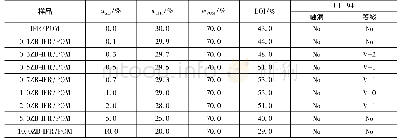《Table 7 UL-94 data, dripping behavior, and LOI values of neat PLA and the PLA/PBS blends》
 提示:宽带有限、当前游客访问压缩模式
提示:宽带有限、当前游客访问压缩模式
本系列图表出处文件名:随高清版一同展现
《Synergistic Efficiency of Tricresyl Phosphate and Montmorillonite on the Mechanical Characteristics and Flame Retardant Properties of Polylactide and Poly(butylene succinate) Blends》
a After flame time in the 1st flame application for 10 s;b After flame time in the 2nd flame application for 10 s;c Total flame time;d NR represents no rating;e Ignition of cotton from plastic melt during 10 s flame application;f No dripping UL-94 test
Figure 6 shows the DSC thermograms of neat PLA and the PLA/PBS blends.As discussed above,neat PLA indicated a single Tg of 60.5°C and a Tcc of 115.9°C without Tc.Blending PLA with 20 wt%of PBS(i.e.PLS)remarkably affected its thermal behaviors.The DSC results revealed that the Tg of PLS decreased to 34.4°C in the presence of 20 wt%PBS,or reduced almost 26°C compared to that of neat PLA.These results indicated the increased chain mobility of the PLA/PBS blends affecting its flexibility.A significant reduction in Tcc of the PLS compared to neat PLA of 22°C was also observed.It implied that the presence of PBS accelerated the cold crystallization process in the polymeric chains.However,the Tc of the PLS still disappeared under experimental conditions due to the high cooling rate(10Κ/min),leading to recrystallization of PLA lamellae.These evidences indicated that the drawbacks of PLA are brittleness and a slow crystallization rate.Furthermore,the melting endotherms of PLS were separated into three positions.A single endothermic peak associated with the melting temperature of PBS(Tm1)was noticed at 111.1°C.The higher melting peaks(Tm2 and Tm3)related toα′andαcrystals of PLA appeared at 141.8 and 154.0°C,respectively.Theχc of PLS increased to 38.7%from 32.2%for neat PLA.The thermal parameters of neat PLA and the PLA/PBS blends from DSC results are summarized in Table 5.
| 图表编号 | XD0020168400 严禁用于非法目的 |
|---|---|
| 绘制时间 | 2018.05.01 |
| 作者 | Tunsuda Suparanon、Jiratchaya Surisaeng、Neeranuch Phusunti、Worasak Phetwarotai |
| 绘制单位 | Department of Materials Science and Technology, Faculty of Science, Prince of Songkla University、Department of Materials Science and Technology, Faculty of Science, Prince of Songkla University、Department of Chemistry, Faculty of Science, Prince of Songkl |
| 更多格式 | 高清、无水印(增值服务) |





